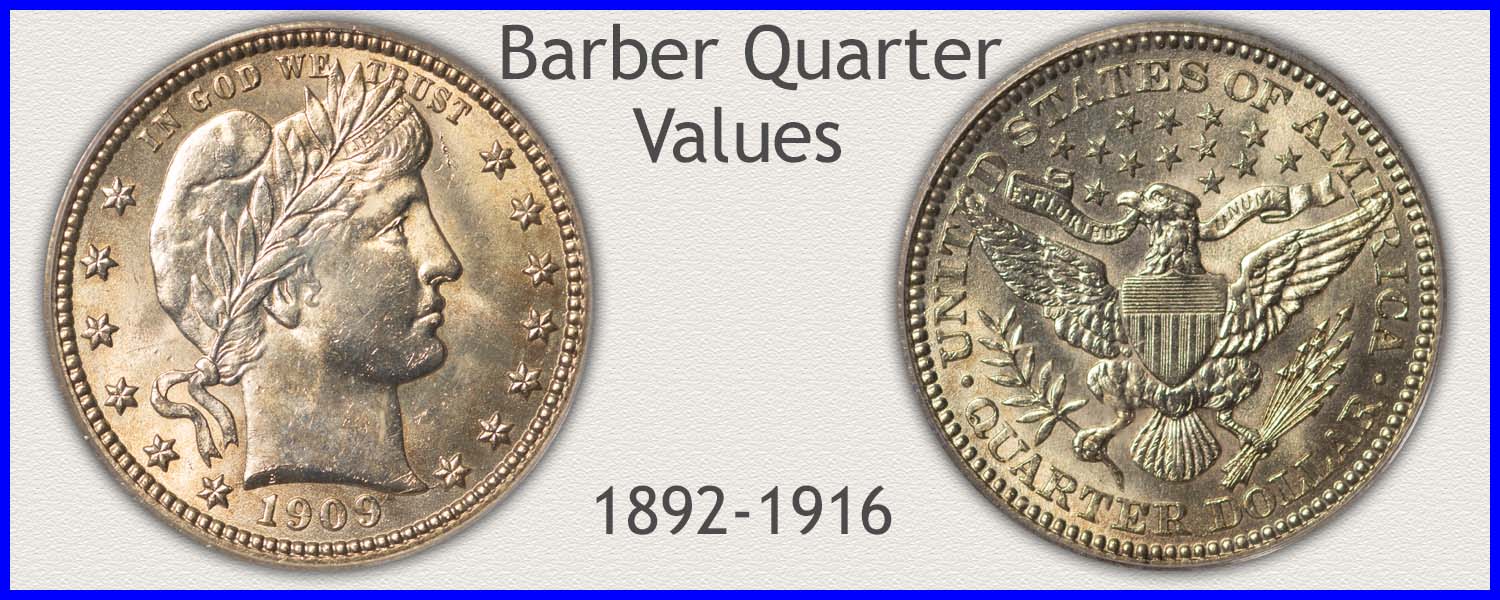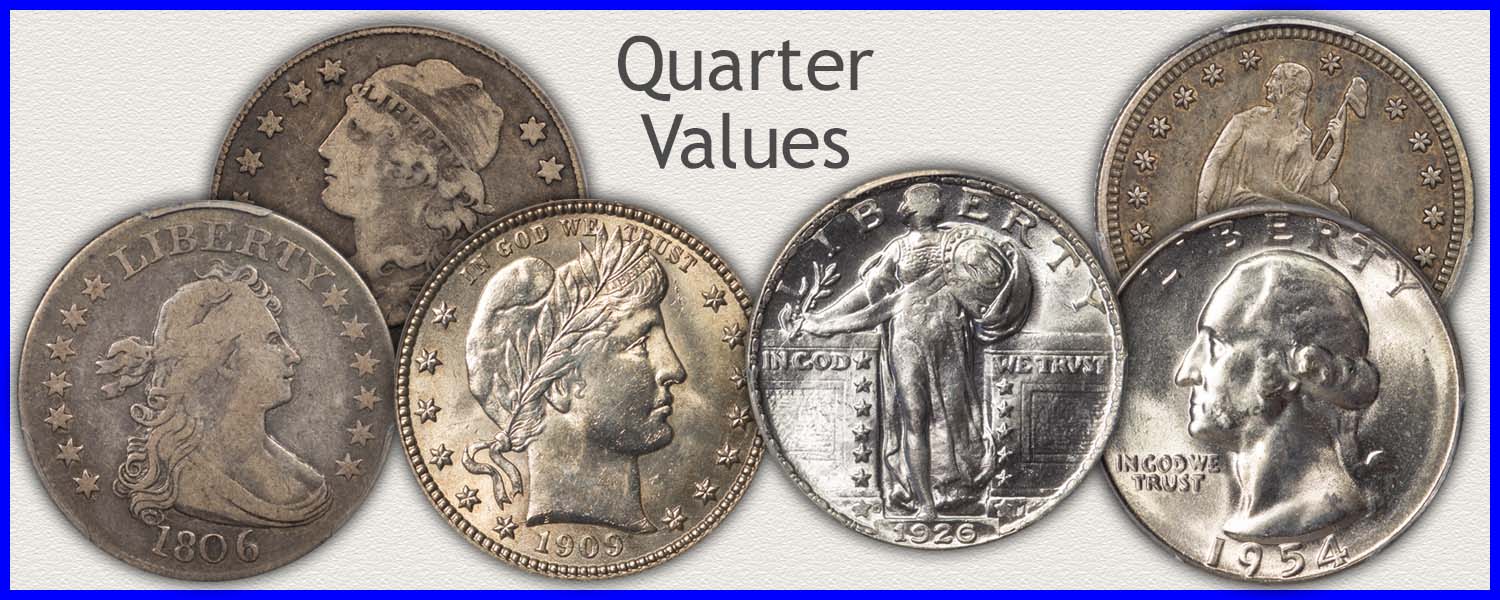Coin Values Moving with Precious Metals: Up-Dated 12/8/2025: Gold $4212 | Silver $58.12
1900 Quarter Value
All Barber quarters, a now-obsolete series, were struck with a 90 percent silver alloy. Today, a nice premium is found in 1900 quarter value.
Minimum worth is $14.03 each, with a collectible percentage included. Market demand is supported by investors, for the precious metal, and collectors who are looking for high-quality examples.
Date and mint combination, as well as judging condition, are used to determine the coin's exact placement on the chart. Follow the steps below with the use of images as a guide.
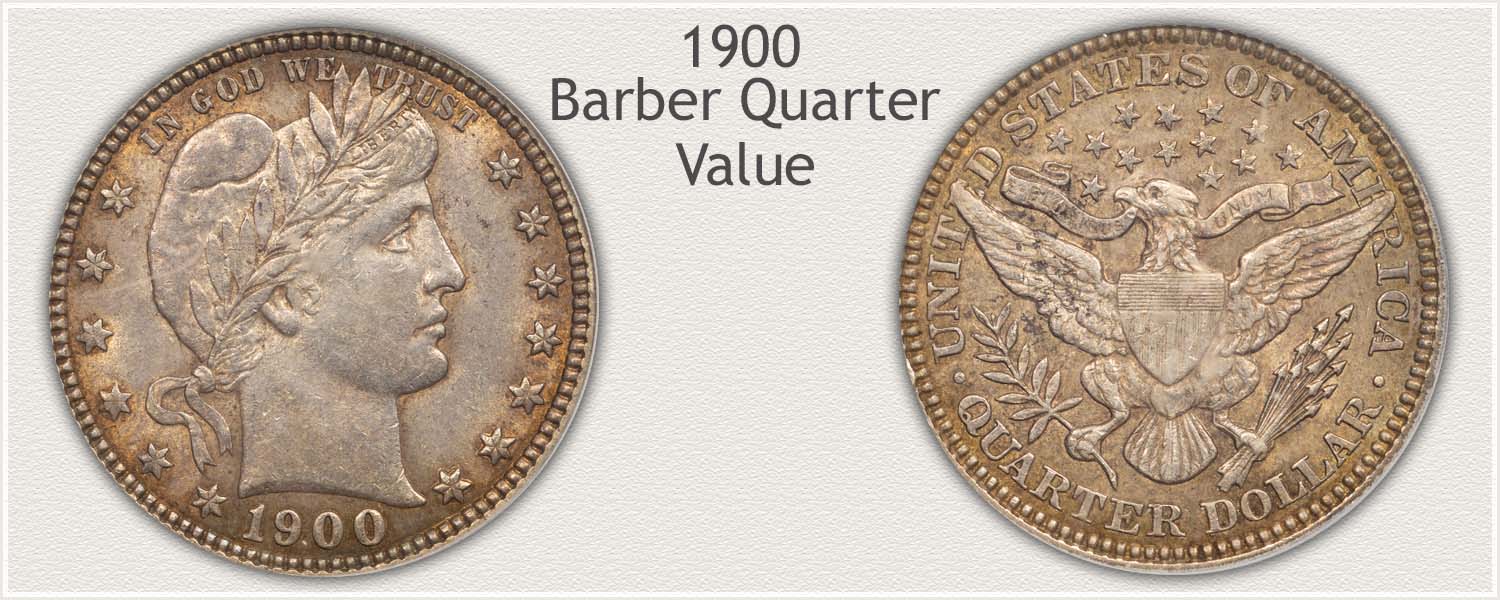
Steps Leading to Value:
- Step 1: Date and Mintmark Variety - Identify those in demand date and mintmark combinations of 1900 quarters needed by collectors.
- Step 2: Grading Condition - In order to determine a coin's value, it is important to judge condition. A grade is assigned to each helping narrow the value range.
- Step 3: Special Qualities - Barber quarters are a 90% silver alloy. These coins all have a premium because of their weight in silver. A surprising amount of precious metal.
| 1900 Quarter Value | ||||
|---|---|---|---|---|
| Condition of Coin | ||||
| Date | Good | Fine | Extremely Fine | Mint State |
| Barber Quarter Values Updated | 12/8/2025 | |||
| 1900 | $14.03 | $17 | $70 | $210 |
| 1900 O | $22.96 | $60 | $175 | $457 |
| 1900 S | $16.15 | $42 | $112 | $402 |
The above chart list wholesale 1900 Barber Quarter values. Computed from dealer's price lists and auction records with various mark-up factors figured in.
Step 1: | Mint Varieties to Recognize
Mintmarks Varieties to Recognize of 1900 Quarters
In terms of 1900 quarter output, the Philadelphia mint continued to produce the highest total of all mints. The issue from Philadelphia is one of three mint varieties struck throughout the year. There were also two Branch mints that contributed coins, although their production was far lower.
A detailed examination is required because of the wide range in values for both mint variety and condition shown on the chart. Presence of mintmarks is verified using images.
1900-S Barber Quarter
"S" Mintmark on Reverse: San Francisco Mint Struck the Coin
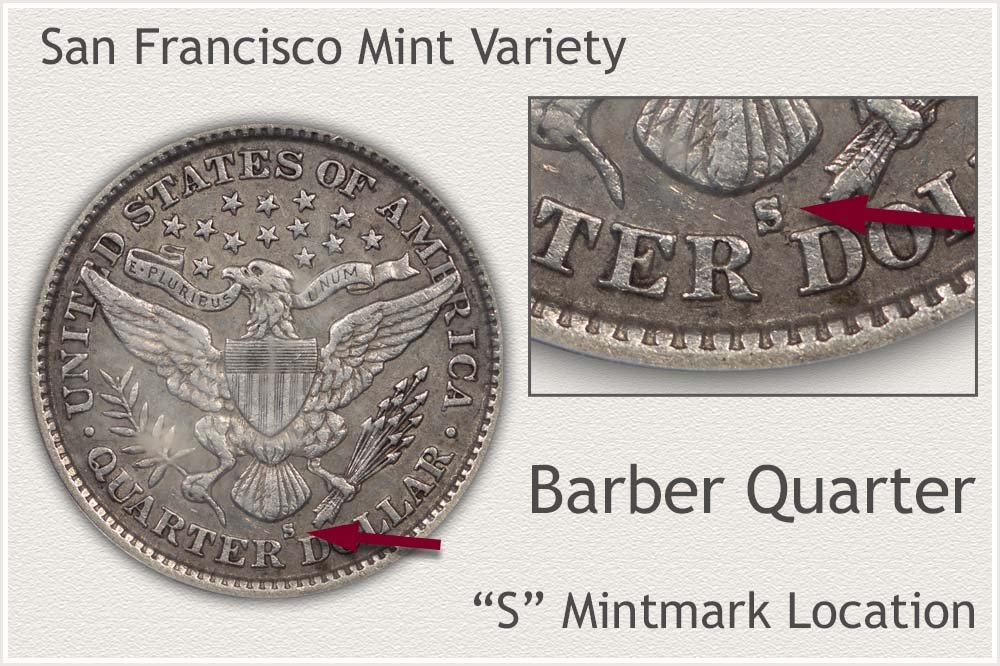
The San Francisco mint struck a total of 1,858,585 quarters in 1900 to begin the new Twentieth century. Of the three mints coining quarters, it became the lowest mint variety of the year. Today these are an affordable and available issue representing an old vintage series as it began a new century.
Collectors have noted the scarcity of any in higher condition. Strong values are listed on the chart for the relatively few remaining with pleasing detail.
As a branch mint of the U.S., San Francisco added an "S" mintmark to distinguish its coins from those issued by other mints. Examine the reverse, finding the "S" mark below the eagle's tail feathers confirms the San Francisco mint issue.
1900-O Barber Quarter
"O" Mintmark on Reverse: New Orleans Mint Struck the Coin
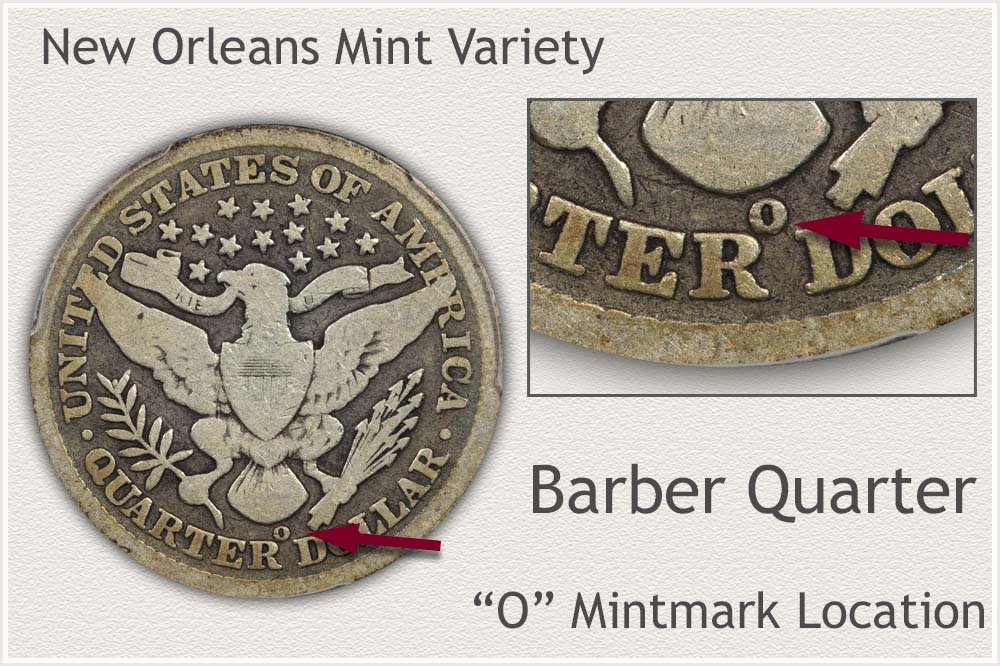
Recognizing the mint issue of the 1900 quarter helps distinguish the premium collector coin from those trading based only its silver content. Due to their association with a now obsolete mint facility, the New Orleans Barber series issues are popular with collectors today. It was the end of an era dating back to 1838 when New Orleans stopped production in 1909.
The majority of the 3,416,000 quarters produced are traded primarily on their silver value due to their extremely worn condition. New Orleans issues of the year typically sell for a modest premium, as noted on the chart. Nicer examples are valuable collectibles.
The letter "O" was used to distinguish New Orleans coinage. Below the eagle's tail feathers, find the "O" mintmark that confirms the coin was produced at the New Orleans mint.
1900 Barber Quarter
No Mintmark on Reverse: Philadelphia Mint Struck the Coin
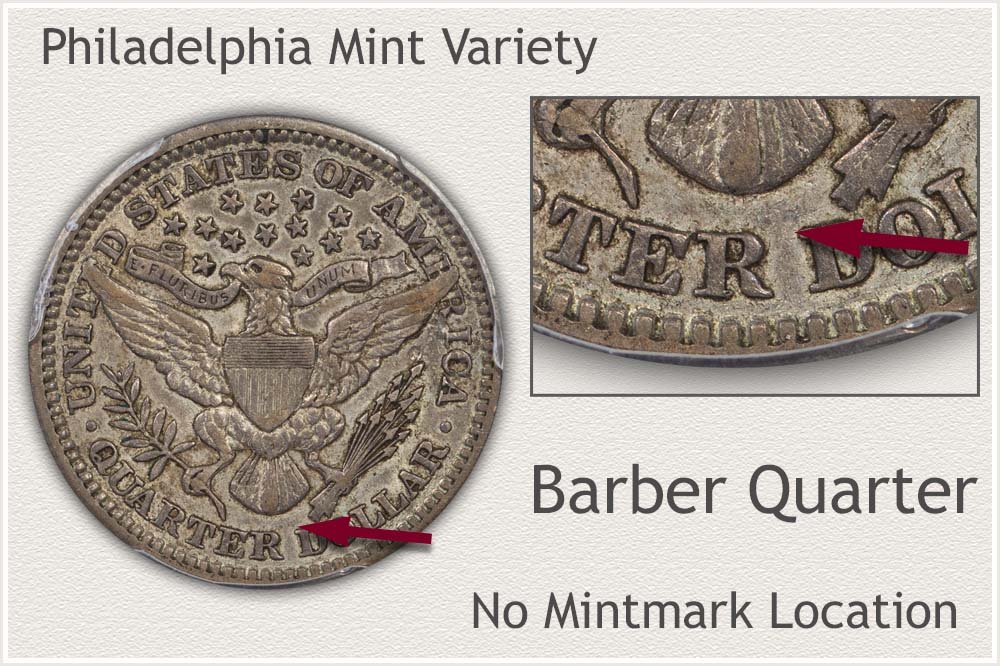
Today, the Philadelphia issue is the most common of the varieties of the year. There were more than 10 million of these quarters produced, greatly exceeding the other two mints. Collectors seek these affordable coins. Investors are also interested in them due to their availability, silver content, and attractive pricing close to the basic silver value.
The chart shows how important condition has become in order to separate and recognize the better, collector pieces. A nice example of high quality remains elusive, despite numerous examples remaining.
The main mint of the United States is located in Philadelphia. It did not use mintmarks on its coinage throughout the Barber series' minting. To verify the coin was struck at Philadelphia, the area where a mintmark would normally be placed is blank. It does not have a mintmark on the reverse, below the tail feathers of the eagle.
Step 2: | Using Images to Narrow Condition to a Grade
Judging Condition, Wear and 1900 Quarter Value
These Barber quarters are valuable as a collectible based on how well they have been preserved. Recognizing the finer detail remaining of the design elements suggests a better condition and grade. Grades are used to describe coins and place a value on them within a certain range.
Magnification is often needed to see some of the more minute details that are described. Using a single light source also helps to illuminate the coin's surface and give it greater contrast. View the full details of the quarters when they were first struck by studying a Mint State coin. As indicated in the various grades, wear begins with the smoothing of the highest relief sections, resulting in lowering condition.
Mint State Grade
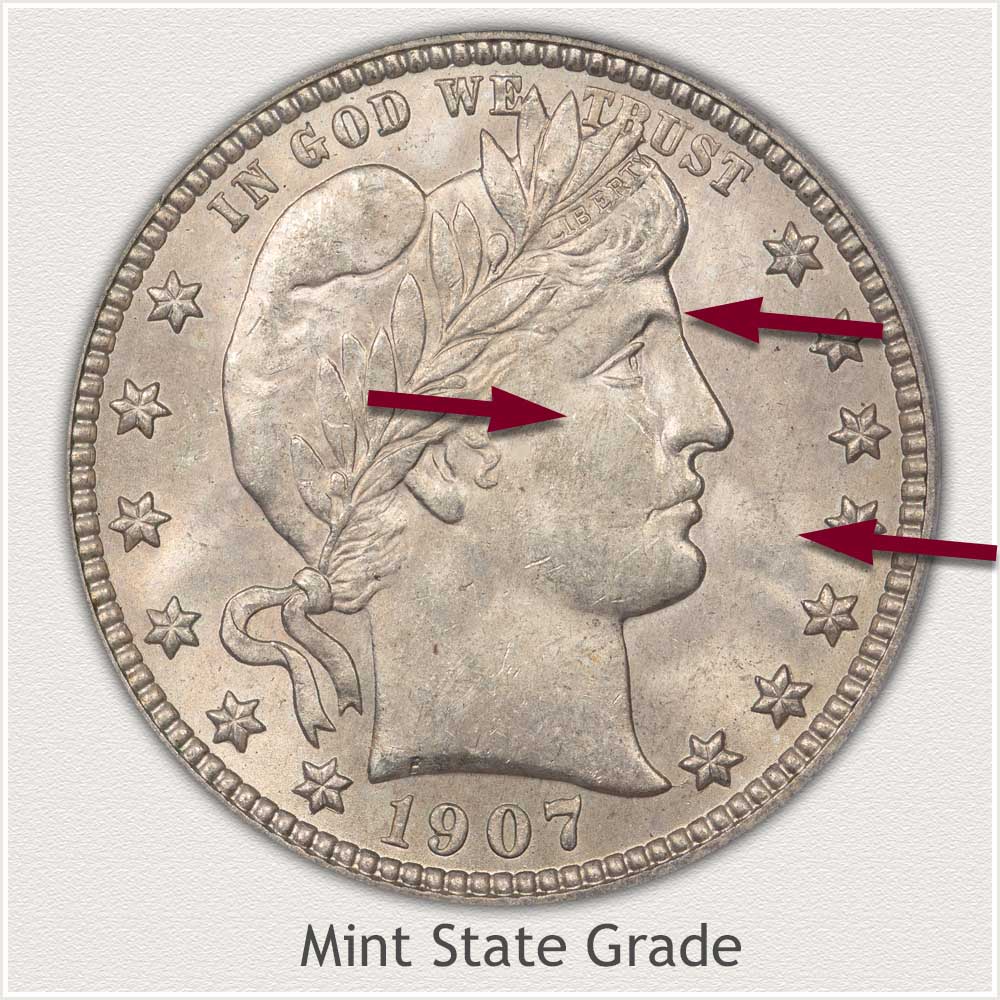
Mint State: Mint State grade is the highest condition category for coins. It defines a coin without surface wear. In addition, the shine, or luster, is uniform and present in both the high relief and low areas of the surface.
The design of these Barber quarters is made of small and major details in raised and recessed areas alike. Looking closely, note the metal on Liberty's eyebrow, a highly prominent feature, has not been smoothed and still has a contoured shape. A flat area is easily produced by wear on the eyebrow.
Also, original luster is a thin, fine texture that reflects light giving these high-grade coins their shine. Tilting a mint state coin under a light, the coin's intact luster shines across Liberty's cheek as well as the fields of the coin. These are exposed areas susceptible to dulling and smoothing from circulation wear. A quarter with complete luster on the cheek and neck is a Mint State example.
Extremely Fine Grade
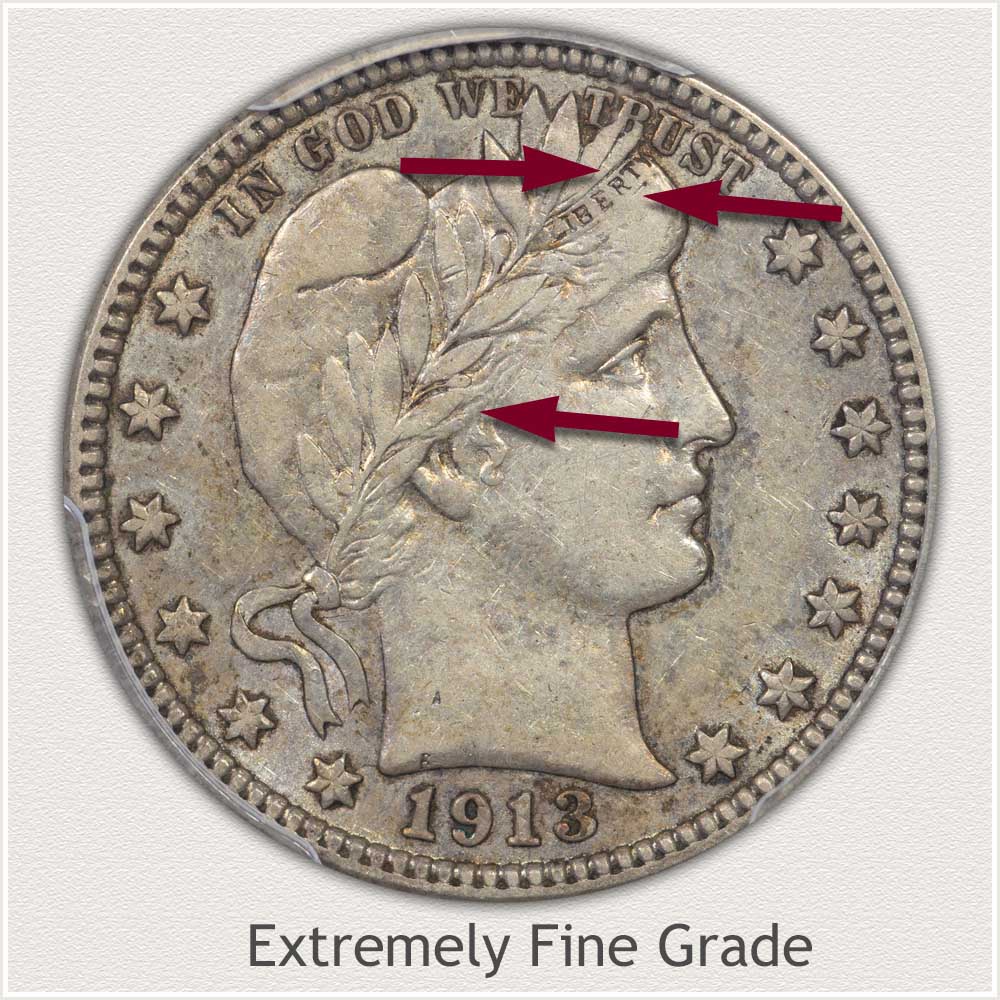
Extremely Fine: Collectors find the Extremely Fine grade very desirable and highly collectible. A coin is considered for this grade when only slight wear is confined to the very peaks of high reliefs. A majority of detail is bold. To recognize this grade, collectors inspect each quarter carefully for a few key points.
An important consideration of the overall design, the letters "LIBERTY" are featured within the headband in Liberty's hair. To qualify for the grade of Extremely Fine, all letters show boldly and remain complete, with no fading into the headband. Looking at the headband itself, the top edge of the band is bold, while the lower edge is evident but slightly less defined. While showing some wear in the same area as the ribbon, Liberty's hair remains well contoured above her forehead.
Second, when closely viewing the leaves on the wreath Liberty is wearing, both the edges of the top row of leaves and, especially, the edges of the bottom row of leaves are clear. This bold detail of leaves and stems identifies a quarter in excellent condition. The highest points of the design are the only areas worn just slightly.
Fine Grade
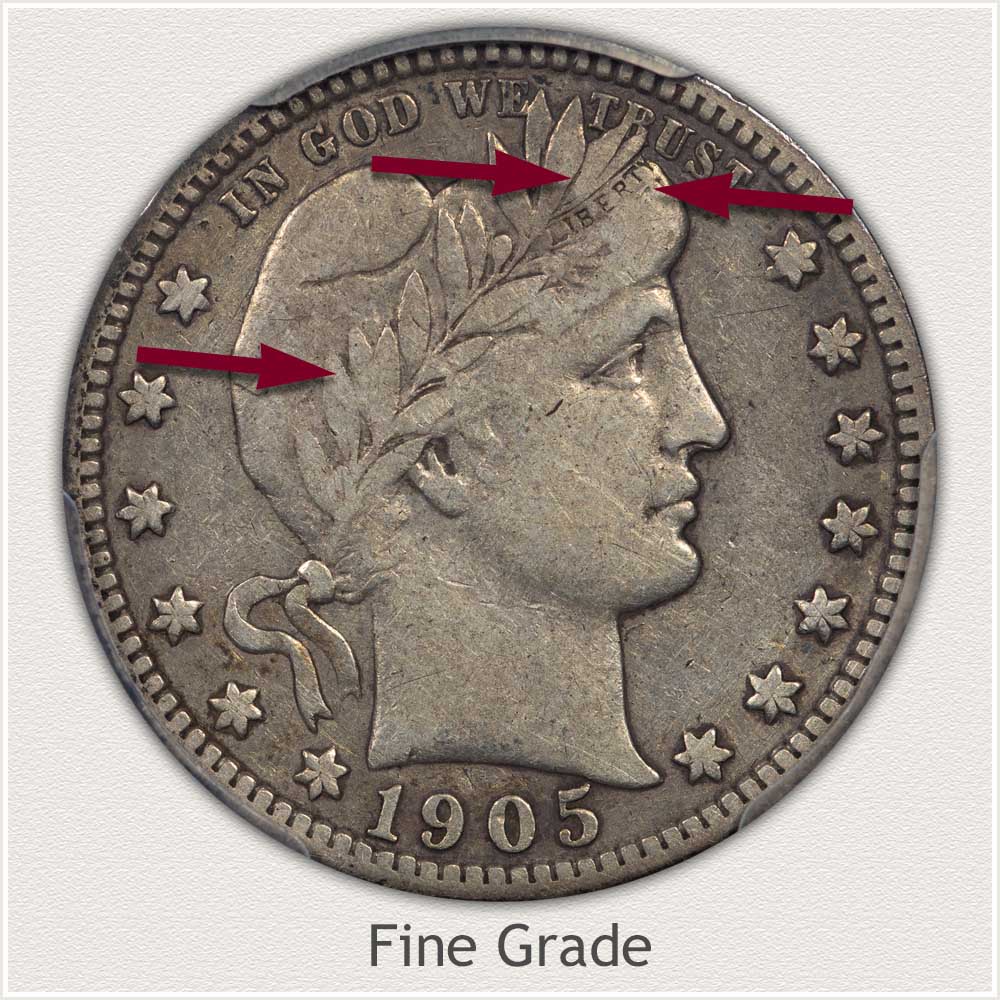
Fine Grade: These nice condition quarters command high premiums due to their large collector base. A Fine grade is given to a moderately worn quarter with many details still present. Each coin is nice quality and features a pleasing amount of detail.
"LIBERTY", part of the headband of the portrait, is one area to examine to judge condition and spot a high-quality example. When all letters are visible on the coin, it is considered in a condition qualifying for the Fine grade. It becomes solid for the grade if parts of the ribbon edges remain on the top and bottom.
When viewed overall, a majority of the original small details are mostly smooth from wear. High and low contours that once defined the wreath's leaves are now smooth and flat. All leaves in the upper row show only faint blending along their edges, but their outlines are clear. The lower row of leaves shows a noticeable blending of the edges.
A nice example of collector quality is a coin with moderate wear and no distracting large marks or dents.
Good Grade
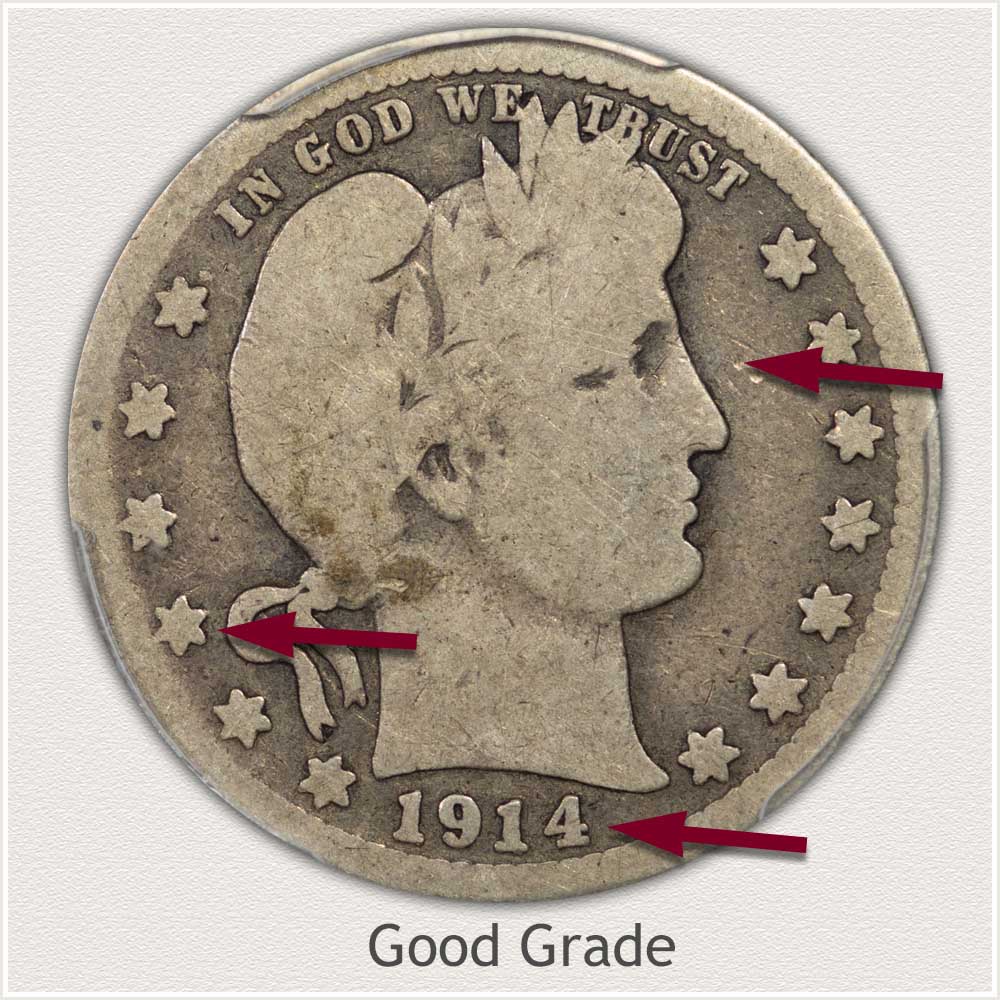
Good Grade: A full presentation of Liberty's portrait contributes to the definition of the Good grade. The design's original details are mostly smooth. Although, in spite of heavy use, the portrait of the coin does not fade into the lower fields.
Remaining details are very bold even though much of the metal and design is worn away. The stars near the rim are clearly separated from it. At the edge of the rim, there is a complete line that does not fade into the background. Additionally, these coins retain a nice appearance due to their bold date.
Note the absence of marks on the surface, as well as the silver-gray color with deeper tones toward the edges. This presents an attractive appearance for a worn Barber quarter.
How to Video: Grading Barber Quarters
By following the video and images, you can focus on specific areas during grading. As features of these vintage quarters, key elements are inspected and used to confirm the quality of the coin's surface and the extent of wear.
Video, Images and Descriptions | Grading Barber Quarters
Step 3: | Special Qualities and Starting Silver Value
How Much Silver in a Barber Quarter?
Barber quarters are silver coinage and have a solid base to value. All dates and mints of the series 1892 to 1916 are 90% silver and 10% copper.
The total amount of pure silver in each quarter is 0.18 ounce.
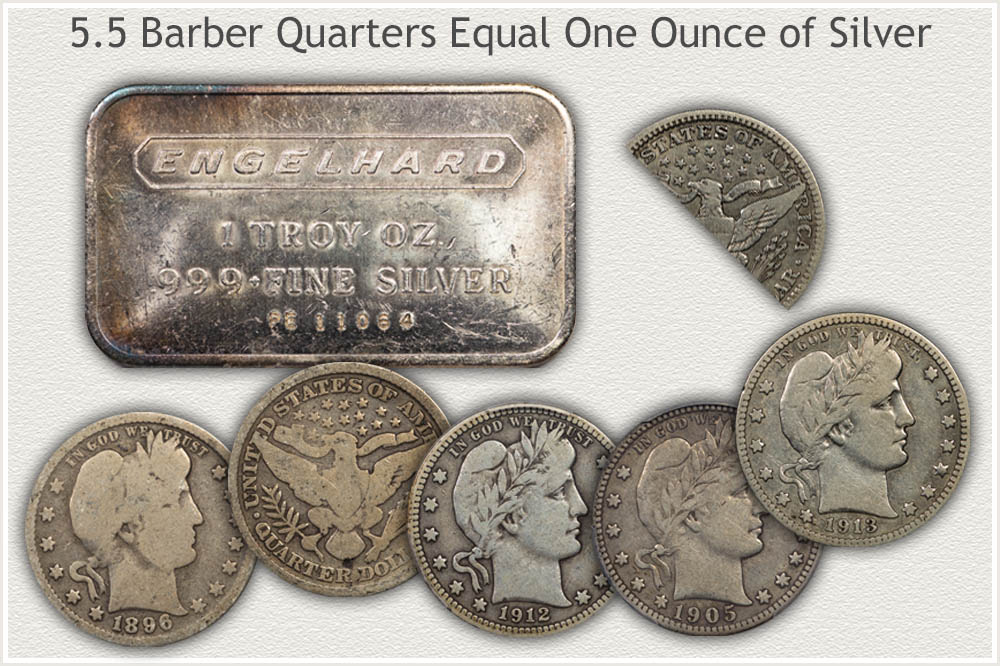
With the amount of silver in each quarter just under one fifth ounce, 5.5 quarters are needed to total one ounce of silver.
Silver in 1900 and Silver Today
Silver prices, as reported by the New Your Exchange, averaged 62 cents an ounce in 1900. A high of 65 cents in July and a low of 60 cents in January of 1900.
Today, 12/8/2025 , silver trades in the $58.12 per ounce range.
Adding to the strong silver base value of these quarters is the special qualities of the vintage Barber series, these are now very old, and enjoy a growing collectible status. Premiums are developing over silver and adding to how much they are worth.
A 1900 quarter is a high mintage issue, along with other available dates and mints of the Barber series trading near its silver price. Lower condition examples are part of an active bullion silver market. With the addition of the special qualities, each trades in a range close to $14.03 as a minimum.
References
U.S. Mint. 1900 U.S. Mint Annual Report.
https://nnp.wustl.edu/library/book/320
U.S. Mint. 1916 U.S. Mint Annual Report
https://nnp.wustl.edu/library/book/514129
Coin Values | CoinStudy Articles
Date by Date
In Depth Barber Quarter Values
1892 to 1916
Barber Quarter Value | Many Scarce Dates
1900 is just one of twenty-five dates to the Barber quarter design series. Each is valued separately on the full value chart. Steps identifying date, mint, and condition lead to finding an accurate place on the chart.
Quarter Values | Scarce Series and Designs
Many appealing designs are part of the quarter denomination of U.S. coinage. Barber quarters were minted long after the first quarter in 1796. Bust and Seated quarters are the very early issues and highly valued. Identify your old quarter with images and links to the series.
Quickly identify the many different U.S. coinage series. Refer to the chart listing starting values and linking to complete coverage of your coin. Images are used in a step-by-step process to accurately determine worth.
Print the Coin Values Worksheet
List valuable Barber quarters individually with important date, mint and condition descriptions. Continue with the rest of your collection. Record current values organizing your coin holdings.
Silver Coin Values | Minimum Values of U.S. Silver Coins
Two strong markets exist in old silver U.S. coinage. Collectible quality premium examples and bullion quality coins trading at base silver value. Identify the vintage silver coinage with images and descriptions and using the calculator place a current value on the silver bullion quality coins.
Safe Coin Storage | Recommendations
Circulated coins show wear, nicks, and marks form use. Mint state coins are at risk of discoloration and darkening over time. Proper storage helps protect, maintain, and preserves condition and values. Collectors use individual and bulk storage options to house their collections and groups of coins.
Barber quarters of the available issues in heavily worn grades have a strong value based on their silver content. Using images, identify U.S. silver coinage, calculate current worth, and reference dealer listings to find buyers of these silver coins.
Coin Grading Services | Professional Review of Your Coins
The series of coin, date and mint are evident on coins. Identifying the Grade of a coin is a skill of judging condition. When the potential of value is entering the hundred-dollar range and above, professional grading is often a good option. Subtle points to condition are expertly assessed. The top two services are reviewed.
★Coin Values Discovery finds 1900 Quarter Value and...
All old coin values. Images are used to follow a step by step method when determining how much U.S. coinage is worth.
